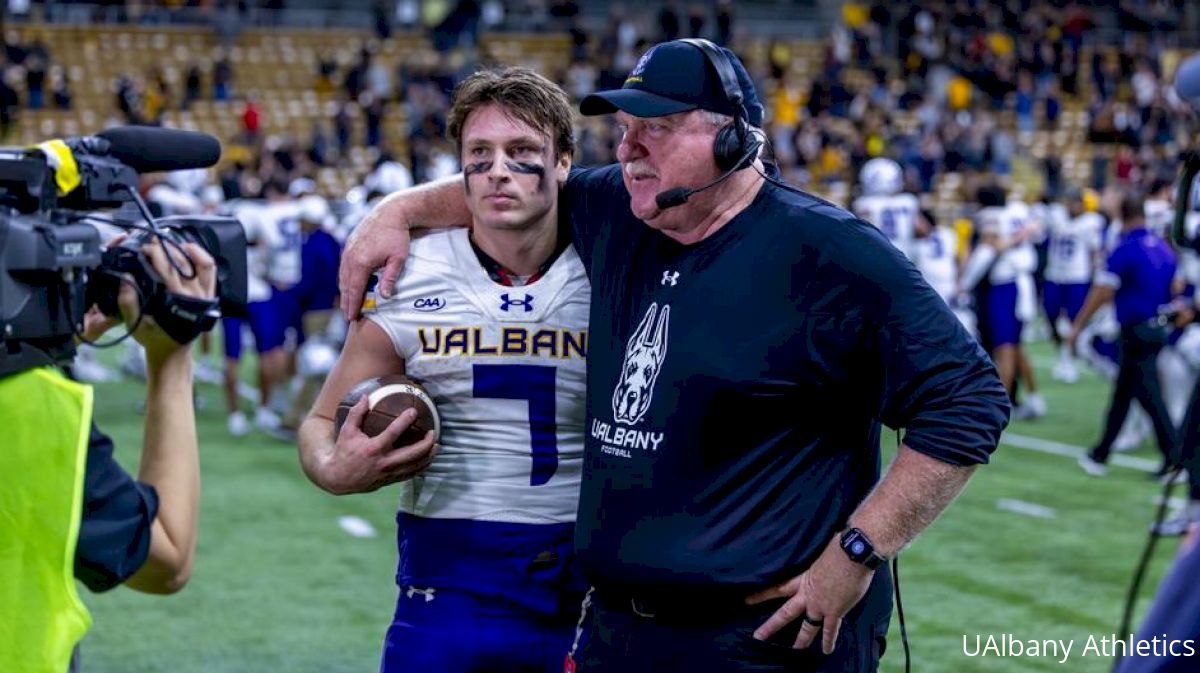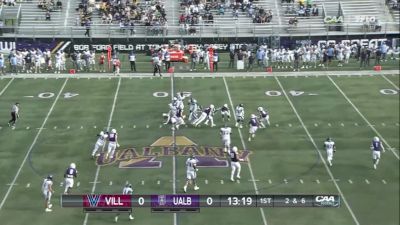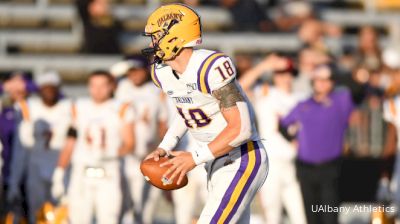CAA Notebook: FCS Playoffs Run Represents The Dream For UAlbany Football
CAA Notebook: FCS Playoffs Run Represents The Dream For UAlbany Football
With its 30-22 FCS Playoffs win over Idaho, UAlbany reached a milestone that reflects the big dreams Great Danes football have for the future.

A 30-22 win at Idaho in the FCS Playoffs quarterfinals continues a season that has been the unequivocal best in UAlbany football history. Knocking off the Vandals in the Kibbie Dome in thrilling, comeback fashion doubles as a reward for perseverance against uniquely difficult circumstances.
"We knew our time was going to come if we continued to work hard," Gattuso said. "To be in the final four is awesome. Obviously, not many people thought we'd be there, but we were able to beat a good Idaho team on their home turf and earn our way in. I know we're the new guys on the block, but hopefully this is the start of what we've all dreamt up here at UAlbany."
?????? ??!
— FloFootball (@FloFootball) December 11, 2023
For the first time in school history, the Great Danes are advancing to the NCAA FCS Semifinals!@UAlbanyFootball | @CAAFootball pic.twitter.com/SLFVMq3r1t
UAlbany is indeed the new guy among the final four: North Dakota State has advanced to this phase of the postseason every year since 2011; Montana is a stalwart of the Playoffs dating back to the 1990s; and South Dakota State is the reigning national champion.
Each of those programs began their runs as FCS heavyweights somewhere, though. NDSU was in just its second FCS Playoffs in 2011 when it won the first of seven national championships. Montana endured a decade marked mostly with sub-.500 finishes before Don Read coached the 1989 Griz to the semifinals — and then to the national title in 1995.
South Dakota State, UAlbany's semifinal opponent on Dec. 15, went 30 years between postseason appearances: The 1979 Jackrabbits qualified for the Div. II Playoffs, but did not make it back to a tournament until 2009. They needed another eight years thereafter before reaching the semifinals.
Now, South Dakota State carries the banner for all of FCS. The defending champion extended its winning streak to a remarkable 27 games with a hard-fought, quarterfinals win over Villanova.
The 23-12 loss was only the second Wildcats' defeat against FCS competition this season — the other came against UAlbany, one of two wins the Great Danes scored against their 2023 CAA co-champions.

Indeed, each of UAlbany's fellow semifinalist started their presence on the national landscape somewhere. This year could be deemed the Great Danes' somewhere, though it fulfills the promise shown four years ago.
The 2023 campaign has surpassed 2019 as the benchmark for UAlbany football. The Great Danes went into the 2020 offseason fresh of its best finish since joining the Coastal Athletic Association in 2013, having been in contention for the CAA championship that autumn and winning an FCS Playoffs game for the first time in program history.
After posting records below .500 in four of its first six seasons after joining the CAA, and never finishing higher than a tie for sixth in the standings, UAlbany's 9-5 mark and second-place finish in 2019 seemed to signal a turning point.

"There's been some ups and downs, which is kind of normal. There's still a transition when you move up from the [Northeast Conference] into a league like the CAA," coach Greg Gattuso said.
UAlbany joined the NEC in 1999 under the direction of program legend Bob Ford. Ford, who assumed the role as head coach in 1970, built UAlbany football up from a club team, into the NCAA Div. III ranks, then into a transitional phase as a Div. II member before going Div. I-AA in the mid-1990s.
Our program wouldn't be where it is today without Coach Bob Ford ?#UAUKNOW #WinTheDay ?? pic.twitter.com/eIKn6irVKH
— UAlbany Football (@UAlbanyFootball) December 10, 2023
The Great Danes didn't need long to contend in the NEC, winning a conference title by 2002 and claiming at least a share of the league crown five more times through 2012. Their run included an appearance in the 2011 FCS Playoffs.
The NEC has different scholarship allotments than many other FCS leagues. But also, moving to the CAA simply means a considerable jump in weekly competition, and an adjustment is inevitable.
The CAA's strength is evident in this postseason marking the 10th over the last 11 in which the league had a representative in the national semifinals. That run is all the more impressive considering the variety of programs to accomplish that feat:
- James Madison: 2021, spring 2021, 2019 (national runner-up), 2017, 2016 (won national championship)
- Maine: 2018
- Richmond: 2015
- New Hampshire: 2014
- Towson: 2013 (national runner-up)
UAlbany is the conference's sixth different semifinalist in a decade, and the Great Danes will try to become the CAA's third program to reach the National Championship Game in that stretch.
The continuation of this dream season picks up where UAlbany had left off in 2019, when its dream was deferred.
The Great Danes rode momentum unlike any they'd had in the previous 50 years of the program's history. Ups-and-downs after changing conferences is indeed "normal," as Gattuso noted, but an event unprecedented in the previous 100 years of human history immediately following UAlbany's 2019 season was anything but normal.
"I really believe we never really got a chance to build off that 2019 season," Gattuso said, referring to the COVID-19 pandemic shutting down the globe beginning in March 2020. "It was the pinnacle of what we had accomplished to that point, and then it just fell off a cliff because of the circumstances in the world."
Inability to recruit traditionally and the cancelation of high school football events, moratoriums on group meetings, and a shortened season played a full 15 months after UAlbany's 2019 Playoffs ended all contributed to stymying the Great Danes' momentum.
Some of the changes that came to college football as a result of the pandemic, however, helped UAlbany reestablish and exceed the trajectory it lost as a result of the pandemic. Retooled transfer rules resulted in plenty of programs losing marquee players — UAlbany was no exception, with Jared Verse going to Florida State and becoming an FBS All-American in a move Gattuso has praised as "one of the positive stories of the transfer portal."
Transfers have also been good for this Great Danes roster, evident in the quarterfinals win at Idaho.
Quarterback Reese Poffenbarger shined with his three passing touchdowns, all to wide receiver Brevin Easton. Poffenbarger transferred into UAlbany from Old Dominion, and Easton came by way of Div. II Assumption.
This kid is unbelievable ?@ReesePoffenbarg ➡️ @Brevineaston01 #UAUKNOW #WinTheDay ?? pic.twitter.com/9kNgjyG9pp
— UAlbany Football (@UAlbanyFootball) December 10, 2023
*inhales* BREVINNNN
— UAlbany Football (@UAlbanyFootball) December 10, 2023
TD #3 for the day !!!! @Brevineaston01 #UAUKNOW #WinTheDay ? ? pic.twitter.com/cY1es6UH85
Another former Div. II player, AJ Simon, demonstrated on the Playoffs stage why he's one of the nation's premier pass-rushers with a pair of quarterback hurries and getting in on a tackle-for-loss vs. the Vandals.
And while they might the same number, 13, it wasn't Easton who made a decleating hit on Idaho punt returner Jermaine Jackson — "That was actually Michael Coleman. He's one of our corners who's outstanding on special teams," Gattuso said. "We're not that crazy to let Brevin cover punts. Not quite." But Coleman is another transfer, coming to UAlbany by way of Toledo.
The NCAA extending eligibility after the pandemic also allowed for underclassmen during the breakout 2019 team, like Larry Walker Jr.,. Ian Renninger and Ozzie Hutchinson, to help get the program rolling again.
UAlbany has also seen recruits from post-COVID signing classes grow into playmakers — former prospects like Elijah Hills and Brad Igweike, who were instrumental to the outstanding defensive performance at Idaho, and walk-on turned scholarship running Griffin Woodell.
As the dream 2023 continues, UAlbany's set the framework to make this dream the program's long-term reality.